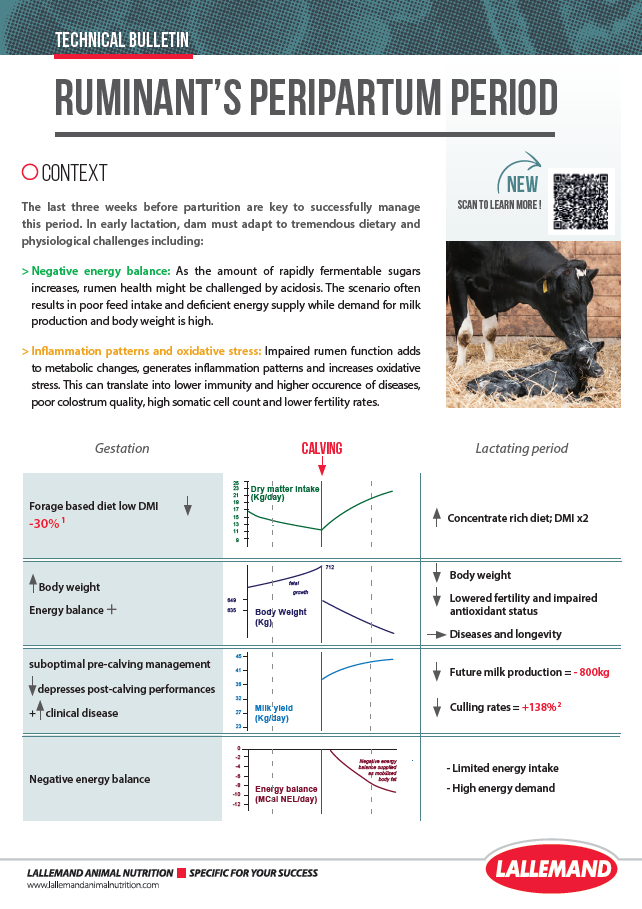Explore our program for the transition period in ruminants
The transition period, from 1 month before to 1 month after parturition, is one of the most challenging stages for ruminants. This critical phase needs to be managed carefully to reinforce rumen preparation, optimize early lactation, and improve dam performance, as well as improve neonate robustness and digestive development. Early lactation is known to be a period of disturbance in the rumen and in lower gut microbiomes.1 Microbiota orientation through adapted nutrition can support early lactation performance.
Our solutions to help cope with transition challenges in ruminant production
Lallemand Animal Nutrition has developed a specific approach based on nutrition with documented results to support ruminants during this challenging period.
The objectives are:
- To optimize rumen microbiota to limit negative energy balance and to extract more nutrients from the diet
- To limit inflammation in the rumen (low pH) and total digestive tract, which can lead to leaky gut
- To bind pathogenic bacteria and mycotoxins within the gut, reinforce gut integrity and immunity
- To support health parameters by improving antioxidant status and supporting offspring robustness
- To maximize forage intake by keeping it palatable with inhibited undesirable yeast and mold growth at feed-out
- To improve reproductive and longevity performance overall
Why choose Lallemand program?
As a global leader in yeast and bacteria production, Lallemand Animal Nutrition has developed a multi-solution approach based on nutrition to help address the challenges of the transition for dairy cows, beef cattle, and small ruminants.
How does the shift to higher energy diets during transition disturb the microbiota balance in the rumen?
- Decrease of fibrolytic microbiota (bacteria and fungi) in early lactation. These populations are responsible for the hydrolyzation of plant fiber in the rumen.
- Increase of starch-digesting bacteria, including lactic acid-producing bacteria with an increased risk of acidosis.
- Decrease of rumen fungi population, which plays a key role in fiber breakdown.
Key figures about transition in ruminants
Want to know more on how to manage the transition period in ruminants?
Contact an expertTo go further
1Monteiro et al., 2022. Rumen and lower gut microbiomes relationship with feed efficiency and production traits throughout the lactation of Holstein dairy cows. Nature. 12:4904
2Trial performed at IRTA, Spain in 2018, and data published in 2018 & 2019 (Bach et al, Journal of Dairy Science, 2018 and 2019)
3Trial performed at INRAE, France in 2020, and data was published in 2021 (Dunièreet al., 2021. Journal of Fungi, 7, 6:447)
4Lallemand Animal Nutrition internal data, 2013. Commercial farm, Switzerland
5Average results from trial: Bach A., IRTA, Spain, 2012; Schwarz. F.J. and Ehle T., University of of Weihenstephan, Germany 2002; Temim S., Veterinary college of Alger, Algeria, 2009
6Lallemand Animal Nutrition internal data. 2020. Commercial farm, Eastern Germany
7Lallemand Animal Nutrition internal data. 2014. Commercial farm, France
8Lysiane Dunière et al., 2021. A live yeast supplementation to gestating ewes improves bioactive molecule composition in colostrum with no impact on its bacterial composition and beneficially affects the immune status of the offspring. BioRxiv, https://doi.org/10.1101/2021.10.14.464371. Results were also presented at the 12th International Symposium on Gut Microbiology, on the 13th of October 2021.
9LallemandAnimalNutritioninternaldata.2017.National Research Institute of Animal Production, Poland
10Hayirlietal.,2002.Models for Predicting Dry Matter Intake of Holsteins During the Prefresh Transition Period. J.DairySci.86(5):1771-1779
11Carvalhoetal.,2019. Long-term effects of postpartum clinical disease on milk production, reproduction, and culling of dairy cows.J.DairySci.102(12):11701-11717
12Diehoetal.,2016.Morphological adaptation of rumen papillae during the dry period and early lactation is affected by the rate of increase of concentrate allowance. J. Dairy Sci. 99(3):2339-2352
